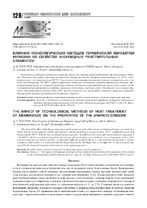| dc.contributor.author | Толстой, А. В. | |
| dc.coverage.spatial | Минск | ru |
| dc.date.accessioned | 2019-10-07T06:30:17Z | |
| dc.date.available | 2019-10-07T06:30:17Z | |
| dc.date.issued | 2019 | |
| dc.identifier.citation | Толстой, А. В. Влияние технологических методов термической обработки мембран на свойства анероидных чувствительных элементов = The impact of technological methods of heat treatment of membranes on the properties of the aneroid sensors / А. В. Толстой // Литье и металлургия. – 2019. – № 3. – С. 126-132. | ru |
| dc.identifier.uri | https://rep.bntu.by/handle/data/57597 | |
| dc.description.abstract | Выполнено исследование влияния температуры закалки на свойства бериллиевой бронзы при последующем старении. Показано, что упругие свойства состаренного материала, закалка которого осуществлялась от 750 °С, существенно ниже, чем закаленного от 760 °С. С увеличением температуры закалки это различие уменьшается и после закалки от температур 770–800 °С уровень упрочнения сплава при последующем старении практически одинаков. Проведены сравнительные исследования структуры и свойств элементов, термообработанных в различных условиях (печах с контролируемой воздушной атмосферой, вакуумных контейнерах, расплаве солей). Установлено, что основной причиной, обусловливающей величину усадки АЧЭ, является различие в их структурном состоянии, вызванное неодинаковым временем прогрева материала до температуры старения. | ru |
| dc.language.iso | ru | ru |
| dc.publisher | БНТУ | ru |
| dc.title | Влияние технологических методов термической обработки мембран на свойства анероидных чувствительных элементов | ru |
| dc.title.alternative | The impact of technological methods of heat treatment of membranes on the properties of the aneroid sensors | ru |
| dc.type | Article | ru |
| dc.identifier.doi | 10.21122/1683-6065-2019-3-126-132 | |
| local.description.annotation | The study of the effect of hardering temperature on the properties of beryllium bronze in subsequent aging were made. It is shown that the elastic properties of the aged material, with the hardening is carried out from 750 °C, significantly lower than hardering from 760 °C. With the increase of quenching temperature, this difference decreases after quenching from temperatures 770–800 °С with the level of hardening of the alloy during subsequent aging is practically the same. Comparative studies of the structure and properties of elements heat – treated under different conditions (furnaces with controlled air atmosphere, vacuum containers, molten salts). It is established that the main reason for the shrinkage value is the difference in their structural state caused by the unequal heating time of the material to the aging temperature. | ru |

